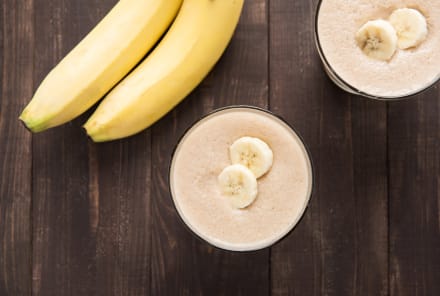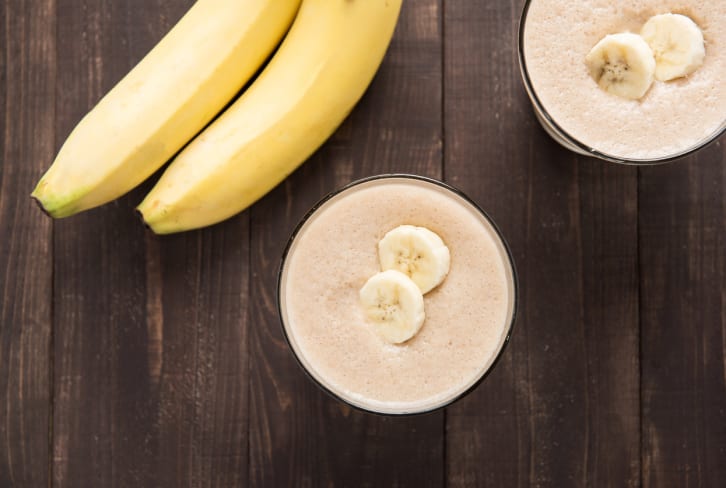Advertisement
Matcha 101: Benefits, Caffeine Content, Side Effects & Recipe Ideas


Matcha has taken the world by storm in recent years, captivating tea enthusiasts and health-conscious individuals alike. But what exactly is matcha, and what makes it so special?
We chatted with health experts and dietitians specializing in Japanese cooking to get the scoop on the benefits of matcha and how to prepare this vibrant tea at home.
What is matcha?
Matcha is a type of powdered green tea from Japan that continues to gain popularity worldwide. What sets matcha apart is its distinctive cultivation and preparation process.
Matcha tea plants are shaded from excessive sunlight using bamboo mats during the growth period. This traditional growing method produces plants that are higher in theanine, antioxidants, chlorophyll, and caffeine1 than other green teas.
Unlike other tea processes where the leaves are steeped and discarded, matcha involves finely grinding shade-grown green tea leaves into a bright green powder. Traditionally, matcha is whisked with a small amount of hot water and served in a bowl to be enjoyed in its pure form.
Matcha's distinct flavor also sets it apart from other teas. While some would describe the taste as grassy and bitter, high-quality matcha prepared correctly will be high in umami and have a slight sweetness.
“In Japan, we say, 'enjoy the taste of green tea, but enjoy the aroma of other tea, such as black tea,'" says registered dietitian Asako Miyashita, MS, RDN, CDN. Miyashita notes that brewing matcha slowly at a low temperature is the secret to a delicious cup.
Summary
Caffeine content of matcha
A typical cup of matcha has around 30-40 milligrams of caffeine, though it can contain far more depending on the brand.
“Matcha has higher caffeine than other green teas. Depending on the type and brand of matcha, one cup might even have more caffeine than the same amount of coffee,” explains dietitian and chef Cindy Chou, RDN.
But matcha also contains the amino acid L-theanine, which helps provides a more balanced energy boost. This is why many people notice the caffeine feels more mild than the caffeine in other teas or coffee. Some Japanese dietitians sip on matcha throughout the day, even after dinner, to help calm their minds before bed.
Here’s how the caffeine content of matcha stacks up against coffee and other teas, according to USDA data. Keep in mind that the exact caffeine content will vary depending on the brand and serving size.
| Drink | Caffeine per cup |
|---|---|
| Japanese matcha | 30-40 mg |
| Green tea | 29.4 mg |
| Black tea | 47.4 mg |
| Coffee | 91.8 mg |
“For healthy adults, drinking 1-2 cups of matcha (up to 2 teaspoons of matcha powder) every day is likely safe,” says Chou. “Keep in mind that the National Institute of Health2 advises people who are pregnant, planning to become pregnant, or are breastfeeding to limit caffeine intake to less than 200 milligrams per day.”
Summary
Benefits of matcha
Additionally, matcha contains L-theanine, an amino acid that promotes relaxation and mental alertness3, providing a calm and focused energy boost.
Due to its potential for preventing many diseases and supporting cognitive function, regular matcha consumption may positively affect both physical and mental health. Here are its most promising health benefits.
It's high in antioxidants.
Green teas, like matcha, contain a considerable amount of catechins, the most abundant being epigallocatechin gallate (EGCG), a group of flavonoids with antioxidant and anti-inflammatory properties4. The high polyphenolic content of matcha is better at scavenging free radicals than vitamin C on its own1.
“Matcha is particularly high in a type of antioxidant called polyphenols1, which have been shown to have many health benefits themselves,” says dietitian Jennifer Akimoto, MAN, RD. “The benefits of matcha may be more of the synergistic effects5 of several different compounds, including caffeine and vitamin C, theanine, and chlorophyll."
It may enhance cognitive function.
“Many studies showing health benefits are from green tea and not specific to matcha. However, there have been some small studies examining the benefits of matcha on brain function6,” says Akimoto. “Theanine, in combination with caffeine, has been found to improve attention and reaction rates in older adults7.”
Matcha improves cognitive function5 both in the short and long term because the theanine in matcha promotes a calm nervous system, explains William Siff, L.Ac MscAOM, acupuncturist and clinical herbalist.
“Its moderate caffeine content helps to amplify the cognitive effects of the theanine5, and the two together create a unique, balanced state of mind that is both alert and relaxed," Siff adds. "The compounds in matcha help to improve clarity, reduce anxiety, and improve memory and focus5.”
It may have cardioprotective effects.
The EGCG and rutin in matcha green tea have been associated with cardioprotective properties1. EGCG may reduce oxidative stress and prevent the activation of certain proteins and signaling pathways that trigger inflammation in our body. When interacting synergistically with vitamin C, rutin is a potent antioxidant that may strengthen blood vessels8.
“Studies have shown that drinking green tea on a daily basis may help to reduce the risk of cardiovascular disease9, with EGCG potentially lowering LDL-cholesterol levels9.” says Chou. “Though, more research is needed.”
It may have anticancer properties.
Phenolic acids, like those found in matcha, have high antioxidant and anti-inflammatory potential, which may inhibit cancer cell growth and prevent metastasis1.
EGCG in green teas, like matcha, seems to have some special abilities that could help fight against 10cancer11 by preventing the growth of blood vessels that feed tumors, protecting our cells from damage, and reducing the risk of cancer-causing processes. Consuming large amounts of EGCG may reduce the incidence of colorectal and biliary duct cancers1 and inhibit the growth and proliferation of gallbladder and bile duct cancer cells.
It may support metabolism.
Some phenolic acids found in matcha can help control how our bodies digest and absorb fats and carbohydrates, which may offer support in managing metabolic 1 conditions1. Matcha may also help lower blood glucose levels and improve insulin sensitivity.
In a small study of adult females, consuming matcha daily for three weeks enhanced exercise-induced fat oxidation12 during a 30-minute brisk walk.
Studies have shown that green tea extracts can reduce body weight and waist circumference 13when combined with a balanced diet and regular physical exercise. While most studies showing metabolic benefits are from green tea and not specific to matcha, they do come from the same plant and contain similar compounds.
Matcha side effects
As with most things, matcha does have some potential downsides to consider.
“If you consume matcha on an empty stomach, it can be irritating or cause some queasiness,” says Siff. “It’s traditionally served with little mochi sweets in Japan for that reason. Accompany your matcha with something small to eat to offset its astringency and bitterness.”
Siff adds that lower-quality matcha tends to have a higher tannin content and lower L-theanine content, making it more likely to upset or overstimulate the stomach. (We're sharing tips on buying a high-quality powder below.)
Miyashita points out that matcha also contains tannins, which may cause dizziness or interfere with iron absorption14, and oxalates, which can trigger or contribute to kidney stones15 in some people who are more sensitive to oxalates.
How to make matcha
With the right tools, matcha tea is very easy to make at home.
“Traditionally, matcha is made using a bamboo whisk, called a chasen. It adds air to your matcha and creates a lovely foam and froth,” explains Akimoto. If you don't have a chasen, you can use a mason jar, Akimoto adds. Simply add a small amount of water to the jar, followed by your matcha powder, close the jar, and shake.
“Matcha tends to clump when it comes into contact with liquids, so it’ll help to sift it with a fine mesh strainer before mixing,” says Chou. Traditionally, matcha is served without any sugar or milk.
Matcha latte recipe
Courtesy of Asako Miyashita, MS, RDN, CDN
Serving size 1
Ingredients:
- 1.5-2 teaspoons (3-4 grams) of matcha powder
- 30-40 milliliters water in 80-90℃ (176-194°F) temperature
- 200-250 milliliters of milk/plant-based milk
- Optional: your favorite sweetener/spice/matcha powder as topping
Method:
- Measure matcha powder and sift it into a tea bowl using a tea strainer. The tea strainer helps get rid of clumps.
- Add boiled water and cool it to 80-90℃ (176-194°F). Pour 30-40ml of hot water into matcha in the tea bowl.
- Whisk the tea until you don't see any clumps. A bamboo whisk is better, but use a spoon or frother if you don't have it. If you still see clumps, strain the tea one more time with the tea strainer.
- Warm the milk and fill the tea bowl with the milk - use a milk frother or whisk to combine. If you do not have a frother or whisk but still want to form milk, shake the milk in a container with a lid, and then add it to matcha)
Other ways to drink matcha
Once you have this basic preparation down, here are a few creative more ways to serve your matcha.
Hold a traditional Japanese tea ceremony
Functional nutrition expert Michiko Tomioka, RDN, IFNCP, has been seriously practicing chado (traditional Japanese tea ceremony) for years. One thing she wants people to understand about matcha is that it’s not just a tea, but a way of living.
Chado says that serving matcha to others is a way to promote hospitality between a host and their guest. So while you can make a matcha latte with a blender, Tomioka says taking the time to prepare matcha with the proper bamboo whisk gives the host a moment of calm and the privilege of enjoying the aroma of matcha while preparing it for their guest.
The traditional way of preparing matcha enhances flavor, umami, and fragrance.
Use it for smoothies and lattes
Straight matcha can be an acquired taste, which is why many people add milk and sweeteners to create creamy drinks like lattes and smoothies that offset some of the bitterness of the matcha.
“If you don’t have a whisk or frother, you can use a blender on lower speeds to mix sifted matcha with water first, then add your choice of milk to make a latte,” says Chou.
Add it to baked goods
You can also add its flavor and characteristic green color to pastries, cookies, loaves, and other baked goods. Akimoto says its umami flavor is a nice addition to desserts because it's not too sweet.
"In baked goods, coconut milk pairs especially well with the umami and slight bitterness of matcha," says Chou.
Sip it iced
“Pure, whisked matcha is great over ice," Siff says. "It’s also nice to add lemon or lime juice to an iced matcha, along with a preferred natural sweetener. This preparation really enhances the fresh, lighter, uplifting qualities of matcha."
He notes that you can also add a citrus-flavored electrolyte powder to your iced matcha for extra hydration.
Enhance its nutrition with a greens powder
"To enhance the nutrient profile, you can add moringa or ashitaba powder to your matcha," says Siff. "This works for hot, iced, and latte formats.” He suggests using a ratio of ⅔ matcha to ⅓ greens powder.
How to buy matcha
When shopping for matcha powder, you’ll typically see ceremonial or culinary-grade matcha.
“Ceremonial-grade matcha is meant to be enjoyed on its own. Culinary-grade matcha can be paired with different plant-based milks and sweeteners,” says Chou.
While more expensive, ceremonial-grade matcha from Japan is the highest quality and provides a distinct flavor that is not bitter.
Culinary-grade matcha still has many of the same health benefits, but it tends to taste more bitter and isn't as pleasant for daily drinking.
When shopping for matcha, look for products that are organic or use a designation on their label that they are grown without chemicals.
Summary
Frequently Asked Questions
Are there side effects of drinking matcha?
People who are sensitive to caffeine may experience side effects like jitters, anxiety, faster heart rate, nausea, headache, and even insomnia if they consume too much matcha. Matcha tends to be higher in caffeine than other green teas, but lower in caffeine than coffee.
How often should you drink matcha?
For healthy adults, drinking 1-2 cups of matcha (up to 2 teaspoons of matcha powder) every day is likely safe.
Does matcha speed up metabolism?
Most studies showing metabolic benefits are from green tea and not matcha specifically, but they come from the same plant and contain similar compounds, so possibly. More research is needed in this area.
The takeaway
Matcha is a powerful beverage with a rich history. Rich in antioxidants, matcha may support metabolic health, cognitive function, and more. Whether you prefer ceremonial-grade matcha for its pure taste or culinary-grade matcha for creative kitchen delights, incorporating matcha into your daily routine can be as tasty as it is healthy. Check out some other top teas for well-being here.
15 Sources
- https://www.ncbi.nlm.nih.gov/pmc/articles/PMC7796401/
- https://www.acog.org/clinical/clinical-guidance/committee-opinion/articles/2010/08/moderate-caffeine-consumption-during-pregnancy
- https://www.ncbi.nlm.nih.gov/pmc/articles/PMC6836118/
- https://www.ncbi.nlm.nih.gov/pmc/articles/PMC7231151/
- https://www.ncbi.nlm.nih.gov/pmc/articles/PMC9792400/
- https://www.ncbi.nlm.nih.gov/pmc/articles/PMC8156288/
- https://www.ncbi.nlm.nih.gov/pmc/articles/PMC7760932/
- https://www.ncbi.nlm.nih.gov/pmc/articles/PMC9493033/
- https://www.ncbi.nlm.nih.gov/pmc/articles/PMC9729734/
- https://pubmed.ncbi.nlm.nih.gov/26530716/
- https://pubmed.ncbi.nlm.nih.gov/26530716
- https://pubmed.ncbi.nlm.nih.gov/29345213/
- https://pubmed.ncbi.nlm.nih.gov/32372444/
- https://www.ncbi.nlm.nih.gov/pmc/articles/PMC5998341/
- https://www.ncbi.nlm.nih.gov/pmc/articles/PMC6459305/
Watch Next
Enjoy some of our favorite clips from classes
Enjoy some of our favorite clips from classes
What Is Meditation?
Mindfulness/Spirituality | Light Watkins
Box Breathing
Mindfulness/Spirituality | Gwen Dittmar
What Breathwork Can Address
Mindfulness/Spirituality | Gwen Dittmar
The 8 Limbs of Yoga - What is Asana?
Yoga | Caley Alyssa
Two Standing Postures to Open Up Tight Hips
Yoga | Caley Alyssa
How Plants Can Optimize Athletic Performance
Nutrition | Rich Roll
What to Eat Before a Workout
Nutrition | Rich Roll
How Ayurveda Helps Us Navigate Modern Life
Nutrition | Sahara Rose
Messages About Love & Relationships
Love & Relationships | Esther Perel
Love Languages
Love & Relationships | Esther Perel











